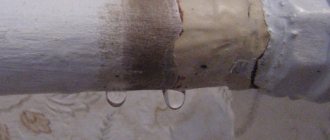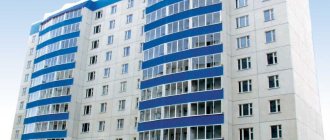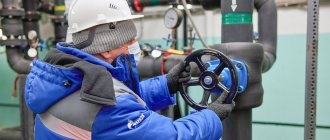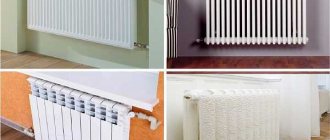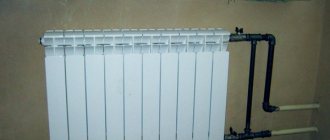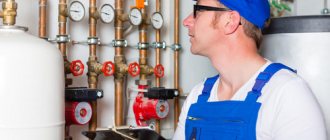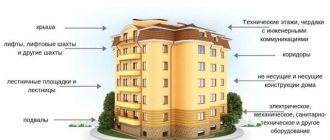Parameters for calculating heating systems: radiators
Heating optimization is related to the thermal output of heating devices.
Radiator batteries have an interval of 140-220 watts. The second parameter for calculation can be found in SNiP; to heat 1 square area, 100 watts are required. This is a rounded value; rooms differ in the degree of insulation.
Types of radiators
Cast iron radiators
Cast iron batteries have proven themselves well. Reliable, have good thermal characteristics. They are inert, take a long time to heat up, but take longer to cool down.
The power of cast iron radiators is calculated by sections; the heat output of one section is 150 watts.
Aluminum radiators
Good heat dissipation up to 200 watts per section, they heat up quickly, but are not durable. They have poor contact with other metals and begin to deteriorate upon contact. Operating temperature - 70 °C
Steel radiators
Good heating, does not have power characteristics like aluminum or cast iron. The power is indicated in the product passport, depending on the size and design: 200W-10kW. Designed to operate at a coolant temperature of 70 °C.
EFFECT OF TEMPERATURE ON COOLANT CHARACTERISTICS
In addition to the factors listed above, the temperature of the water in the heating pipes affects its characteristics. The method of functioning of gravity heating systems is based on this. As the water heating value increases, it expands and circulation appears.
COOLANTS FOR HEATING SYSTEMS
But when using antifreeze, exceeding normal temperatures in radiators can lead to different results. Therefore, for heating with a coolant other than water, it is necessary to first determine the permissible heating values. This does not apply to the temperature of the central heating radiators in the apartment, since such devices do not use antifreeze-based liquids.
Antifreeze is used if there is a risk of exposure to low temperatures on radiators. Unlike water, it does not change from liquid to crystalline at 0 degrees. But if the heat supply operation exceeds the norms of the temperature table for heating to a greater extent, the following phenomena may be observed:
- foaming This contributes to an increase in coolant volume and pressure level. There will be no reverse process when the antifreeze cools;
- the appearance of limescale. Antifreeze contains mineral components. If the heating temperature in the apartment is violated, they precipitate. Over time, this leads to clogged pipes and radiators;
- increase in density. Malfunctions of the circulation pump may occur if its rated power was not designed to handle such situations.
Therefore, it is much easier to monitor the water temperature in the heating system of a private home than to control the heating level of antifreeze. Moreover, substances based on ethylene glycol emit gases that are harmful to humans when evaporated.
Today they are almost never used as a coolant in autonomous heating systems. Before using antifreeze in heating, it is necessary to replace all rubber seals with paranitic ones. This is due to the high level of permeability of this type of coolant.
OPTIONS FOR NORMALIZING HEATING TEMPERATURE CONDITIONS
Minimum water temperatures in the heating system are not considered the main threat to its operation. This affects the microclimate in living rooms, but does not affect the operation of the heating supply. If the water heating norm is exceeded, emergency situations may occur.
SAFETY GROUP FOR AUTONOMOUS HEATING
When creating a heating scheme, you need to provide a list of measures aimed at preventing a critical increase in water temperature. First of all, this will lead to increased pressure and stress on the inside of pipes and radiators. If this happened once and lasted a short time, then the heating parts will not be damaged.
But such cases appear under the constant influence of specific factors. Most often this is the incorrect operation of a solid fuel boiler. To avoid breakdowns, it is necessary to upgrade the heating in the following way:
- installation of a security group. It consists of an air vent, a bleed valve and a pressure gauge. If the water temperature reaches a critical level, these parts will eliminate excess coolant, thereby ensuring normal circulation of the liquid for its natural cooling;
- mixing unit. It connects the return and supply pipes. Additionally, a two-way valve with a servo drive is mounted. The latter is connected to the temperature sensor. If the heating level exceeds the norm, the valve will open and a mixing of hot and cooled water flows will occur;
- electronic heating control unit. It distributes the water temperature in different parts of the system. If the thermal regime is violated, it sends a corresponding signal to the boiler processor to reduce power.
These measures will prevent improper heating operation at the initial stage of the problem. It is most difficult to control the water temperature in systems with a solid fuel boiler
Therefore, for them, special attention must be paid to the selection of indicators of the safety group and mixing unit
Adjustment
Automatic control is provided by the heating regulator.
It includes the following parts:
- Computing and matching panel.
- Actuating device on the water supply section.
- An actuator that performs the function of mixing liquid from the returned liquid (return).
- Boost pump and sensor on the water supply line.
- Three sensors (on the return line, on the street, inside the building). There may be several of them in the room.
The regulator closes the liquid supply, thereby increasing the value between return and supply to the value specified by the sensors.
To increase the flow, there is a boost pump and a corresponding command from the regulator. The incoming flow is controlled by a "cold bypass". That is, the temperature decreases. Some of the liquid that has circulated along the circuit is sent to the supply.
Sensors collect information and transmit it to control units, resulting in a redistribution of flows that provide a rigid temperature scheme for the heating system.
Sometimes, a computing device is used that combines hot water and heating regulators.
The hot water regulator has a simpler control scheme. The hot water sensor regulates the flow of water with a stable value of 50°C.
Advantages of the regulator:
- The temperature scheme is strictly maintained.
- Elimination of overheating of the liquid.
- and energy efficiency
- The consumer, regardless of the distance, receives heat equally.
Heat supply of a multi-storey building
Heating distribution unit for an apartment building
Heating distribution in a multi-storey building is important for the operational parameters of the system. However, in addition to this, the characteristics of the heat supply should be taken into account. An important one is the method of supplying hot water - centralized or autonomous
An important one is the method of supplying hot water - centralized or autonomous.
In most cases, a connection is made to the central heating system. This allows you to reduce the current costs in the estimate for heating a multi-storey building. But in practice the level of quality of such services remains extremely low. Therefore, if there is a choice, preference is given to autonomous heating of a multi-storey building.
Autonomous heating of a multi-storey building
autonomous heating of a multi-storey building
In modern multi-storey residential buildings, it is possible to organize an independent heat supply system. It can be of two types - apartment-based or communal. In the first case, the autonomous heating system of a multi-storey building is carried out in each apartment separately. To do this, make independent piping and install a boiler (most often a gas one). A common house installation involves the installation of a boiler room, which has special requirements.
The principle of its organization is no different from a similar scheme for a private country house. However, there are a number of important points to consider:
- Installation of several heating boilers. One or more of them must perform a duplicate function. If one boiler fails, another must replace it;
- Installation of a two-pipe heating system of a multi-storey building, as the most efficient;
- Drawing up a schedule for scheduled repairs and maintenance work. This is especially true for heating heating equipment and safety groups.
Taking into account the peculiarities of the heating scheme of a particular multi-storey building, it is necessary to organize an apartment-by-apartment heat metering system. To do this, energy meters must be installed on each incoming pipe from the central riser. That is why the Leningrad heating system of a multi-storey building is not suitable for reducing operating costs.
Centralized heating of a multi-storey building
Elevator unit diagram
How can the heating distribution in an apartment building change when it is connected to a central heating supply? The main element of this system is the elevator unit, which performs the functions of normalizing coolant parameters to acceptable values.
The total length of the central heating mains is quite large. Therefore, at the heating point, such coolant parameters are created so that heat losses are minimal. To do this, increase the pressure to 20 atm. which leads to an increase in the temperature of hot water to +120°C. However, given the characteristics of the heating system in an apartment building, supplying hot water with such characteristics to consumers is not permitted. To normalize the parameters of the coolant, an elevator unit is installed.
It can be calculated for both a two-pipe and a single-pipe heating system in a multi-storey building. Its main functions are:
- Reducing pressure using an elevator. A special cone valve regulates the volume of coolant flow into the distribution system;
- Reducing the temperature level to +90-85°C. A mixing unit for hot and cooled water is designed for this purpose;
- Filtration of coolant and reduction of oxygen content.
In addition, the elevator unit performs the main balancing of the single-pipe heating system in the house. For this purpose, it is equipped with shut-off and control valves, which automatically or semi-automatically regulate pressure and temperature.
You also need to take into account that the estimate for centralized heating of a multi-story building will differ from autonomous heating. The table shows the comparative characteristics of these systems.
Tips for optimizing heating performance
Even the most accurate temperature schedule of a heating boiler room will exhibit deviations in calculated and actual data during operation. This is due to the operating features of the system. What factors can influence the current temperature regime of heat supply?
- Contamination of pipelines and radiators. To avoid this, the heating system should be cleaned periodically;
- Incorrect operation of control and shut-off valves. The functionality of all components must be checked;
- Violation of the boiler's operating mode - sudden changes in temperature and, as a consequence, pressure.
Maintaining the optimal temperature regime of the system is only possible with the correct selection of its components. To do this, their operational and technical properties should be taken into account.
The battery heating can be adjusted using a thermostat, the operating principle of which can be found in the video:
How coolant is supplied to the heating system
The following restrictions apply to the home heating system:
- The maximum heating indicator is determined by a limited value of +95 degrees for a two-pipe system, as well as 105 degrees for a single-pipe network. In preschool educational institutions, stricter restrictions apply. The water temperature in the battery should not rise above 37 degrees. To compensate for the reduced temperature, additional sections of radiators are built up. Kindergartens, which are located directly in regions with harsh climatic zones, are equipped with a large number of radiators with numerous sections.
- The best option is to achieve the minimum “delta” value, which represents the difference between the supply and return values of the coolant temperature. If you do not achieve this value, then the degree of heating of the radiators will have a large difference. To reduce the difference, it is necessary to increase the speed of the coolant. However, even with an increase in the speed of movement of the coolant, a significant drawback arises, which is due to the fact that the water will return back to the thermal power plant with an excessively high temperature. This phenomenon can lead to disruptions in the functioning of the thermal power plant.
To get rid of this problem, elevator modules should be installed in every apartment building. Through such devices, a portion of supply and return water is diluted. This mixture will allow for accelerated circulation, thereby eliminating the possibility of excessive overheating of the return pipeline.
If an elevator is installed in a private house, then the accounting of the heating system is set using an individual temperature schedule. Two-pipe heating systems in a private house are characterized by 95-70 degrees, and single-pipe heating systems by 105-70 degrees.
Why do temperature fluctuations occur?
The reasons for temperature changes are determined by the following factors:
- When weather conditions change, heat loss automatically changes. When cold weather sets in, to ensure an optimal microclimate in apartment buildings it is necessary to expend more thermal energy than during warming. The level of heat loss consumed is calculated by the “delta” value, which is the difference between the street and indoors.
- The constancy of the heat flow from the batteries is ensured by a stable temperature of the coolant. As soon as the temperature decreases, apartment radiators will become increasingly warmer. This phenomenon is facilitated by an increase in the “delta” between the coolant and the air in the room.
The increase in coolant losses must be carried out in parallel with the decrease in air temperature outside the window. The colder it is outside, the higher the temperature of the water in the heating pipes should be. To facilitate the calculation processes, a corresponding table has been adopted.
general information
Here we present the main provisions and excerpts from the current SNiP.
Outdoor temperature
The calculated temperature of the heating period, which is included in the design of heating systems, is no less than the average temperature of the coldest five-day periods over the eight coldest winters of the last 50 years.
This approach allows, on the one hand, to be prepared for severe frosts, which occur only once every few years, and, on the other hand, not to invest excessive funds in the project. On the scale of mass development we are talking about very significant amounts.
Target room temperature
It is worth mentioning right away that the temperature in the room is affected not only by the temperature of the coolant in the heating system.
Several factors operate in parallel:
- Outside air temperature. The lower it is, the greater the heat leakage through walls, windows and roofs.
- Presence or absence of wind. Strong winds increase heat loss in buildings by blowing through unsealed doors and windows into entrances, basements and apartments.
- The degree of insulation of the facade, windows and doors in the room. It is clear that in the case of a hermetically sealed metal-plastic window with a two-chamber double-glazed unit, heat loss will be much lower than with a cracked wooden window and double-strand glazing.
The external façade is covered with basalt fiber slabs.
And, finally, the actual temperature of the heating radiators in the apartment.
So, what are the current temperature standards in rooms for various purposes?
- In the apartment: corner rooms - not lower than 20C, other living rooms - not lower than 18C, bathroom - not lower than 25C. Nuance: when the estimated air temperature is below -31C, higher values are taken for corner and other living rooms, +22 and +20C (source - Decree of the Government of the Russian Federation dated May 23, 2006 “Rules for the provision of utility services to citizens”).
- In kindergarten: 18-23 degrees depending on the purpose of the room for toilets, bedrooms and playrooms; 12 degrees for walking verandas; 30 degrees for indoor swimming pools.
- In educational institutions: from 16C for bedrooms of boarding schools to +21 in classrooms.
- In theaters, clubs, and other entertainment venues: 16-20 degrees for the auditorium and +22C for the stage.
- For libraries (reading rooms and book depositories) the norm is 18 degrees.
- In grocery stores, the normal winter temperature is 12, and in non-food stores - 15 degrees.
- The temperature in the gyms is maintained at 15-18 degrees.
For obvious reasons, there is no need for heat in the gym.
In hospitals, the temperature maintained depends on the purpose of the room. For example, the recommended temperature after otoplasty or childbirth is +22 degrees, in the wards for premature babies it is maintained at +25, and for patients with thyrotoxicosis (excessive secretion of thyroid hormones) - 15C. In surgical wards the norm is +26C.
Temperature chart
What should be the temperature of the water in the heating pipes?
It is determined by four factors:
- Air temperature outside.
- Type of heating system. For a single-pipe system, the maximum water temperature in the heating system according to current standards is 105 degrees, for a two-pipe system - 95. The maximum temperature difference between supply and return is 105/70 and 95/70C, respectively.
- The direction of water supply to the radiators. For upper filling houses (with supply in the attic) and lower filling houses (with a pairwise loop of risers and the location of both lines in the basement), the temperatures differ by 2 - 3 degrees.
- Type of heating appliances in the house. Radiators and gas heating convectors have different heat output; Accordingly, to ensure the same temperature in the room, the heating temperature regime must be different.
The convector is somewhat inferior to the radiator in thermal efficiency.
So, what should be the temperature of the heating - the water in the supply and return pipes - at different outside temperatures?
We present only a small part of the temperature table for the estimated ambient temperature of -40 degrees.
- At zero degrees, the temperature of the supply pipe for radiators with different wiring is 40-45C, the return pipe is 35-38. For convectors 41-49 supply and 36-40 return.
- At -20 for radiators, the supply and return should have a temperature of 67-77/53-55C. For convectors 68-79/55-57.
- At -40C outside, for all heating devices the temperature reaches the maximum permissible: 95/105 depending on the type of heating system in the supply and 70C in the return pipeline.
Communal complex of Russia
A.R.Eksaev,
ICC "POTOK"
For more than half a century, on the desktop of any self-respecting heating engineer, among the constantly in demand materials, there has invariably been the book of Professor E.Ya. Sokolov, the guru of heat power engineering - “Cogeneration and Heating Networks” [1]. This is a real “heat engineering bible”. Since 1956, when it was first published in its current form, and to this day, much has changed dramatically in our country, as well as throughout the world, but the reason for the relevance of this book has not changed: Russia is a cold northern country with a huge territory and a high degree of urbanization, which in principle cannot do without centralized heat supply. This means that this fundamental work still has a very long life ahead. The mathematical apparatus formulated by E.Ya. Sokolov has not undergone any changes to this day and is recognized as classical.
Having applied modern computer analysis and modeling tools on the CityCom platform to this device, specialists from the Potok Information Computing Center developed and tested a methodology for optimizing the operational temperature schedule of any specific heat source in connection with the actual state of heating networks, connected loads and the requirements for the quality of heat supply as a service.
What is this article all about and what is the task?
- Saving boiler fuel. In the structure of the cost of heat supply, the costs of heat generation are incomparably higher than the costs of pumping coolant through pipes. And if it is technically possible to reduce the temperature of the coolant at least somewhat, compensating for this decrease by increasing the circulation flow rate, this would save a lot of money.
- Operating rules and regulatory documents [2] require that maximum temperature tests be carried out at least once every 5 years. And if the heat supply system operates according to the approved 150/70 schedule, this means that tests must be carried out at a temperature of 150°C. Despite the fact that in real operation the actual temperatures are much lower. Operating enterprises fear these tests like fire - on old, worn-out networks they can lead to physical destruction of pipelines and supporting structures. And if it does, the safety margin of the pipelines after such tests will inevitably decrease, and the risk of accidents during the heating season will increase. It would be good to switch to a lower schedule, having it approved in the heat supply scheme. Then tests can be carried out at more gentle temperatures.
It turns out that switching to a “lower” temperature schedule or even just lowering the coolant temperature by a few degrees without causing serious damage to the heat supply is not at all as simple as it might seem. The next chapter will explain why in some detail. Qualified heating engineers and those who are bored by this can skip it, moving straight from the question “who is to blame?” to the question “what to do?”
What is a “temperature chart” and why is it so important?
Everyday: if the water from the mixer in the kitchen is not hot enough, we close the cold water valve and open the hot water valve more strongly - up to the complete closing of the first and the complete opening of the second (in this case, the DHW meter spins faster).
In a broader sense, any object that consumes heat does exactly the same thing. The only difference is that network water is a means of transporting heat - it is not physically consumed (with the exception of hot water supply according to an “open” scheme), but releases its thermal energy by heating tap water or air in heat exchange devices. And the lower the temperature of the network water, the more and at a higher speed it needs to be “pumped” through the heat exchange installation to extract the same required amount of heat. So, if it’s cold in your house, then you open the regulator on the heating radiator all the way, and if it’s too hot, on the contrary, you “tighten” this regulator, thereby changing the coolant flow.
Hence the obvious conclusion: the selection of the required amount of thermal energy can be achieved in three ways: (a) by changing the flow rate of the coolant - “quantitative regulation”, (b) changing its temperature - “qualitative regulation”, (c) combining a change in temperature with a change in flow rate - “qualitative regulation” -quantitative regulation". Let's remember this.
The pressure in the supply pipeline should always be higher than in the return pipeline (through which the cooled coolant returns back to the heat source). This pressure difference ensures that the coolant is “pushed” through consumers’ heating appliances, where it cools down, giving off its heat to grateful people. The pressure difference in the supply and return pipelines at the consumer connection points is called the “available pressure”. The higher it is, the more opportunities for regulating the consumed thermal energy the heat consuming object has. There is no available pressure, or it is too small to overcome the resistance of the consumer’s internal systems - no heat supply (service not provided). Let's remember this too.
It would seem that what would be simpler is to install such network pumps at the source so that they create an available pressure, which is certainly enough for all consumers, and heat the coolant to a sufficiently high temperature. And let everyone take as much heat as they need, regulating the flow rate in their heat exchange installations and heating devices. But no, it doesn't work that way. And that's why.
It follows from the laws of physics that the available pressure decreases in proportion to the square of the increase in flow rate. This is a very strong influence, and also uneven: with an increase in the flow rate in the main line, the available pressure of consumers of this main line decreases very quickly as they move away from the source, they may completely lose the opportunity to receive their heat and freeze. At the same time, consumers located closer to the source will notice almost nothing and can sleep in winter with their windows open. This is a classic case of network misalignment, leading to a large number of complaints, excessive heat generation costs and even accidents. This is the main reason why quantitative regulation is not used in district heating systems: with significantly variable costs, it is almost impossible to ensure a stable hydraulic regime for uniform provision of thermal energy to all consumers.
Therefore, qualitative regulation of heat supply is usually used, to which, on certain hydraulically “heavy” days that are too cold or too warm, quantitative regulation is added in a small pre-calculated range of permissible flow rates. His Majesty's Temperature Chart serves to practically ensure such regulation.
The temperature graph is a precisely calculated dependence of the absolute temperature of the coolant at the outlet from the source on the outside air temperature. Each average daily air temperature corresponds to a strictly defined temperature of the network water in the supply and (for control) return lines. The idea behind the calculation of the temperature schedule is that throughout the entire range of external temperatures during the heating period in the pipeline system transporting coolant from the source to consumers, costs remain constant (or almost constant). The constancy of costs inherent in the temperature schedule allows, when designing a heat supply system and during its operation, to calculate and carry out “adjustment measures” - installation of special simple hydraulic devices (throttle washers and elevator nozzles) at the subscriber inputs, ensuring an even and stable hydraulic regime throughout the entire heat supply system . A significant change in costs, as noted above, leads to the effect of “misalignment” of the network. For new values of steady-state flow rates and pressures, these devices must be calculated and installed anew (i.e., “readjustment”).
Classic heating temperature graphs of quality control are usually referred to as design temperature values. Thus, the designation of the schedule “150/70” indicates that at an outside air temperature of -26°C (for Moscow), the temperature in the supply pipeline should be 150°C, and in the return pipeline 70°C. These plots are predefined for the sets of constant values used in the design. There are modifications of classic charts with the so-called “upper cut” and “lower cut”. Factors influencing the need for cutting are described in the literature [3], but it is only important for us to know that they distort the linear appearance of the graph, and it is in the cutting zones that a quantitative component (qualitative-quantitative regulation) is added to the qualitative regulation (Fig. 1).
Fig.1. Classic temperature chart 150/70 with cutoffs - “lower” 70°C and “upper” 115°C
So what exactly is the problem, and how to solve it?
- It’s impossible to simply, volutnaristically, lower the temperature by a few degrees by increasing the circulation flow rate without providing an accurate calculation of the consequences. There are many examples when, having done this and saved on heat production, a heat supply company subsequently faces imposed penalties in numerous lawsuits from consumers for a service not provided or of poor quality, and the amount of these fines is several times greater than the savings obtained on heat generation . The reason is the “quadratic dependence” mentioned in the previous chapter in hydraulics and, as a consequence, the imbalance of the mode. We must count carefully.
- Whether it is technically possible to lower the schedule depends on the network capacity reserves. They can only be assessed using a hydraulic calculation of the heating network on an electronic model for industrial purposes (EMPN) [4] (Fig. 2), well calibrated and in daily use. And in most cases it is absent. The electronic model, which may be available in the form of supporting materials for the heat supply scheme, from the point of view of network operation does not stand up to criticism due to its “aggregation” and “generalization”. If it works at all.
Fig.2. Electronic model for industrial purposes (EMPN) on the CityCom-TeploGraph platform
- All actually operated heating equipment of subscriber inputs is designed, installed and adjusted for the temperature schedule that was approved during the design of the entire heat supply system from a given source. This means that in design calculations of both existing and newly introduced heat consumption facilities, a set of technical parameters (constants) characteristic of this particular temperature graph is used. Therefore, simply taking and switching, for example, from the schedule “150/70 with an upper cut-off of 130°C” to the schedule “130/70” without readjusting and upgrading all consumers is impossible in principle - the hydraulics will be “skewed”, the heat supply system will stop working and fulfilling its purpose function.
Solution Approach
When designing heat supply systems, a classic temperature graph is always used - with or without cuts. This is dictated by the “design” approach itself, in which the hypothetical (design) heat consumption by type of heat load is known, and the characteristics of the pipeline network are selected based on the calculated (design) hydraulics.
Over time, due to natural reasons, the hydraulic characteristics of pipelines, absolute values and ratios of types of thermal loads, characteristics of subscriber input equipment, etc. change. Therefore, during the actual operation of the existing heat supply system, the operating parameters in the networks always differ from the design ones, and this is completely normal. At the same time, dispatch services receive feedback in the form of complaints from consumers at those moments when the mode of actual supply of thermal energy from the source or the hydraulic mode in the network does not provide adequate quality of heat supply.
As a rule, at centralized heat sources, logs are kept in which daily measured values of flow rates, pressures and temperatures in the supply, return and make-up pipelines, as well as the average daily outside air temperature are recorded. It turned out that by analyzing the data of such a log over a long period of time (preferably over several years), it is possible to statistically identify with a high degree of reliability the actual absolute loads by type of heat consumption, as well as heat losses, and their real ratios at different intervals of outside air temperatures. Subsequent recalculation of the received daily “instantaneous” loads into the so-called “design” loads (i.e., maximum design for the outside air temperature of the coldest five-day period) provides grounds for recalculating the temperature graph. An interesting observation: the calculated loads obtained based on the analysis of actual conditions, as a rule, turn out to be significantly lower than the design ones, even taking into account heat losses, which suggests the possibility of developing and justifying a reduced temperature schedule for the heat source.
Further, instead of using a “predetermined” classical schedule, we specify only the design constants characteristic of it (to eliminate the need to re-adjust networks) and the required temperature in heated rooms, and for each outside air temperature over the entire temperature range of the heating period, a complete system of equations “named E.Ya. Sokolov” [1] (Fig. 3). If you use flow rate and the nature of its changes within acceptable limits as a variable parameter, you can obtain several options for new temperature schedules that are acceptable for operation, from which the most suitable one is selected from the point of view of the dispatch service and/or economic considerations (Fig. 4). The adequacy of hydraulics for each of the options for the new schedule must be checked on a calibrated electronic model - EMPN [4] (Fig. 2). Options that are unacceptable for “hydraulic” reasons are either immediately rejected or are accompanied by the necessary measures to modernize (relay) critical sections of the networks.
Fig.3. System of equations (classical relations of the subject area) [1]
Fig.4. Reduced schedule (conventional name - “115/55 nonlinear”), calculated based on an analysis of actual modes and proposed for use instead of the “150(115)/70” schedule (Fig. 1)
In order to have grounds for approving the resulting schedule as an operational one, it is necessary to temporarily accept it for execution as a “dispatcher” internal administrative document, and work on it for at least one full heating season (Fig. 5), carefully recording the parameters of the mode at the source, and (if possible) the temperature in heated premises for at least several characteristic consumers, as well as monitoring and recording incoming complaints, if any.
Fig.5. Monitoring and analysis of actual temperatures when operating on a reduced schedule during the heating season
If the heating season is completed satisfactorily according to the new schedule, it can be approved as an operational schedule in the heat supply scheme. Note that the “design” schedule does not disappear anywhere; it remains as such for the purposes of design and new connections.
Want to try?
Everything written above is the result of extensive research and practical work over several years. The results received a positive expert opinion from VTI OJSC, the object of implementation is a real heat supply system of a large Russian city, powered by a thermal power plant, with a population of several hundred thousand inhabitants in the coverage area. Good results have been obtained, the necessary experience has been acquired and tools and methodology have been developed, which will certainly be of interest to many heat supply enterprises, and which we are ready to share for mutual benefit and for the benefit of the industry.
Literature:
- Sokolov E.Ya. “Heating and heating networks” - 7th ed., stereot. - M.: MPEI Publishing House, 2001.
- RD 153-34.1-20.329-2001. Guidelines for testing water heating networks for maximum coolant temperature (UDC 621.311)
- “Justified reduction in coolant temperature (cut)” – NP “Energy Efficient City”, https://www.energosovet.ru/entech.php?idd=38
- Eksaev A.R., Shumyatsky M.G. Electronic models for industrial purposes, magazine "Utilities Complex of Russia" No. 1 (127), 2015 - M.: Publishing House "KKR", 2015.
Parameter control methods
System regulation
Heating can be adjusted. Methods:
- quantitative;
The parameters are changed by increasing or decreasing the amount of coolant supplied. Pumps increase the pressure in the system, valves reduce the speed of the carrier.
- qualitative;
With quality, the parameters of the coolant change, additives are added that change the characteristic indicators.
- mixed.
Uses both methods.
Method for reducing heat loss
The first, main condition for reducing heat loss is good thermal insulation.
The system needs to be optimized. Adjust a comfortable temperature inside living rooms, follow the recommendations for temperature conditions in utility and non-residential premises.
Comfort in home
Table of coolant temperature versus outside air temperature
In order to calculate the optimal temperature regime, you need to take into account the characteristics of heating devices - batteries and radiators. The most important thing is to calculate their specific power, it will be expressed in W/cm2. This will most directly affect the transfer of heat from heated water to the heated air in the room
It is important to take into account their surface power and the resistance coefficient available at window openings and external walls
After all the values are taken into account, you need to calculate the difference between the temperature in two pipes - at the entrance to the house and at the exit from it. The higher the value in the inlet pipe, the higher the value in the return pipe. Accordingly, indoor heating will increase under these values.
| Weather outside, C | at the entrance to the building, C | Return pipe, C |
| +10 | 30 | 25 |
| +5 | 44 | 37 |
| 57 | 46 | |
| -5 | 70 | 54 |
| -10 | 83 | 62 |
| -15 | 95 | 70 |
Proper use of coolant involves attempts by house residents to reduce the temperature difference between the inlet and outlet pipes. This could be construction work to insulate a wall from the outside or thermal insulation of external heat supply pipes, insulation of floors above a cold garage or basement, insulation of the inside of a house, or several works performed simultaneously.
Heating in the radiator must also comply with the standards. In central heating systems it usually varies from 70 C to 90 C depending on the outside air temperature
It is important to consider that in corner rooms the temperature cannot be less than 20 C, although in other rooms of the apartment a decrease to 18 C is allowed. If the temperature outside drops to -30 C, then the heating in the rooms should rise by 2 C
The temperature in the remaining rooms should also increase, provided that it may be different in rooms for different purposes. If there is a child in the room, then it can vary from 18 C to 23 C. In storerooms and corridors, heating can vary from 12 C to 18 C.
How climate zones affect air temperature
The main factor that is taken into account when calculating the temperature schedule is presented in the form of the calculated temperature in winter. When calculating heating, the outside air temperature is taken from a special table for climatic zones.
The coolant temperature table should be drawn up so that its maximum value satisfies the SNiP temperature in residential premises. For example, we use the following data:
- Radiators are used as heating devices, which supply coolant from bottom to top.
- The type of apartment heating is two-pipe, equipped with parking pipe distribution.
- The calculated values of the outside air temperature are -15 degrees.
In this case we receive the following information:
- Heating will be started when the average daily temperature does not exceed +10 degrees for 3-5 days. The coolant supply will be carried out at a value of 30 degrees, and the return will be equal to 25 degrees.
- When the temperature drops to 0 degrees, the coolant value increases to 57 degrees, and the return flow will be 46 degrees.
- At -15, water will be supplied at a temperature of 95 degrees, and the return will be 70 degrees.
This is interesting! When determining the average daily temperature, information is taken from both daytime thermometer readings and nighttime measurements.
Temperature regulation
Employees of heating networks and thermal power plants are responsible for the parameters of the heating main, and the temperature indicators inside the buildings are in the department of the housing office. To regulate the room temperature during the heating season, two methods can be used.
The first is called quantitative and involves a change in water flow at constant temperatures. If a qualitative method is used, then the volume of coolant consumed remains constant, but its thermal parameter changes.
It is the second option that is used most often, as it is the most economical. A high-quality method of heat regulation allows you to provide comfortable living conditions even with sudden changes in temperature outside.
For a heat energy consumer, knowledge of coolant supply standards can be useful. This is due to the fact that if the schedule parameters are not observed, a recalculation for utilities may be required. To measure the thermal index of the coolant, it is not necessary to install complex heat metering devices in the apartment. It is enough to drain a small amount of water from the radiator into a container and then take a measurement.
How is the heat of the water in the batteries regulated?
It is clear that if there is a dependence on external factors, then there must be ways of regulation. Today, there are two options for controlling the water temperature in the system: quantitative and qualitative.
- The quantitative method involves changing the volume of water circulating in the system while maintaining its temperature. When you turn the regulator located on the radiator in your apartment, you use this method.
- The qualitative method consists of maintaining the total volume of liquid as its temperature changes. This method ensures greater independence of the heating system from sudden changes in weather, it is more efficient and rational, therefore it is used when organizing the operation of thermal power plants, and the process of collecting data and regulating the work is automated.
Temperature graph of sources and heating networks
The dependency schedule may vary. A specific diagram has a dependency on:
- Technical and economic indicators.
- CHP or boiler room equipment.
- Climate.
High coolant values provide the consumer with great thermal energy. Below is an example of a diagram, where T1 is the temperature of the coolant, Tnv is the outside air: A diagram of the returned coolant is also used.
A boiler house or thermal power plant can estimate the efficiency of the source using this scheme. It is considered high when the returned liquid arrives chilled. The stability of the scheme depends on the design values of fluid flow of high-rise buildings. If the flow through the heating circuit increases, the water will return uncooled, as the flow rate will increase. Conversely, with minimal flow, the return water will be sufficiently cooled.
The supplier's interest, of course, is in the supply of return water in a cooled state. But there are certain limits for reducing consumption, since a decrease leads to loss of heat.
The consumer’s internal temperature in the apartment will begin to drop, which will lead to violation of building codes and discomfort for ordinary people. What does it depend on? The temperature curve depends on two quantities: outside air and coolant. Frosty weather leads to an increase in coolant temperature. When designing a central source, the size of the equipment, building and pipe size are taken into account. The temperature leaving the boiler room is 90 degrees, so that at minus 23°C, the apartments are warm and have a value of 22°C. Then the return water returns to 70 degrees. Such standards correspond to normal and comfortable living in the house.
How is it calculated?
A control method is selected, then a calculation is made. The calculated winter and reverse order of water supply, the amount of outside air, and the order at the break point of the diagram are taken into account. There are two diagrams: one of them considers only heating, the second considers heating with hot water consumption.
For an example of calculation, we will use the methodological development of Roskommunenergo.
The input data for the heat generating station will be:
- Tnv – the value of outside air.
- TV - indoor air.
- T1 – coolant from the source.
- T2 – reverse flow of water.
- T3 – entrance to the building.
We will look at several heat supply options with values of 150, 130 and 115 degrees.
At the same time, at the exit they will have 70°C.
The results obtained are compiled into a single table for subsequent construction of the curve:
So, we have three different schemes that can be used as a basis. It would be more correct to calculate the diagram individually for each system. Here we examined the recommended values, without taking into account the climatic features of the region and the characteristics of the building.
To reduce energy consumption, it is enough to select a low temperature setting of 70 degrees and uniform heat distribution throughout the heating circuit will be ensured. The boiler should be taken with a power reserve so that the system load does not affect the quality operation of the unit.
